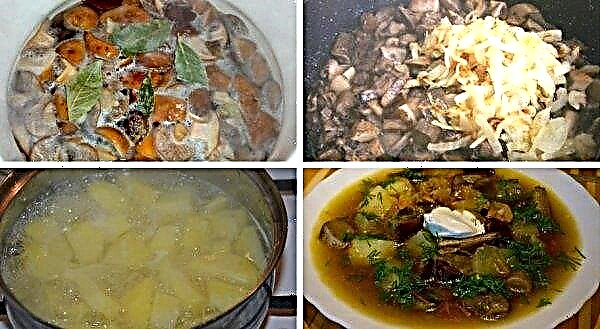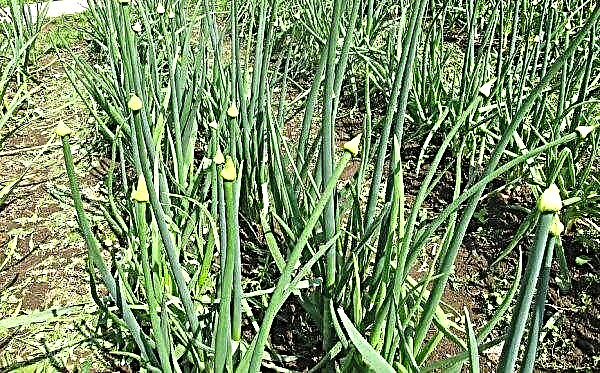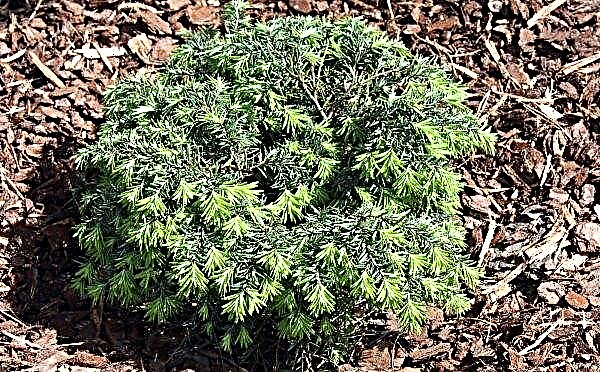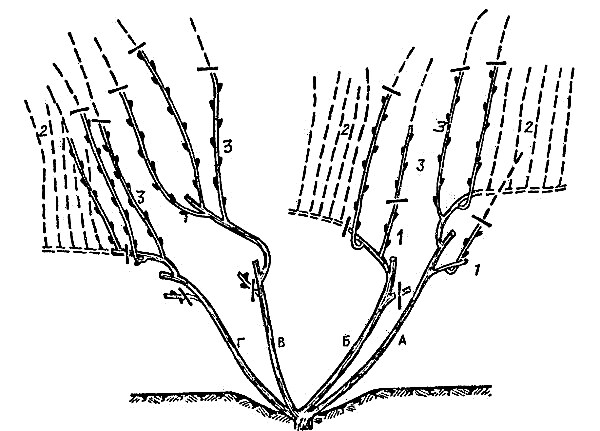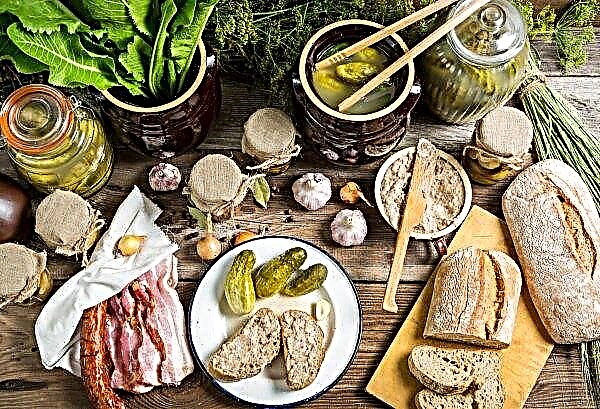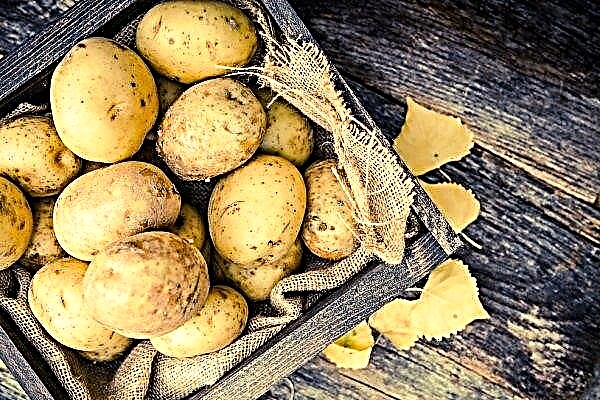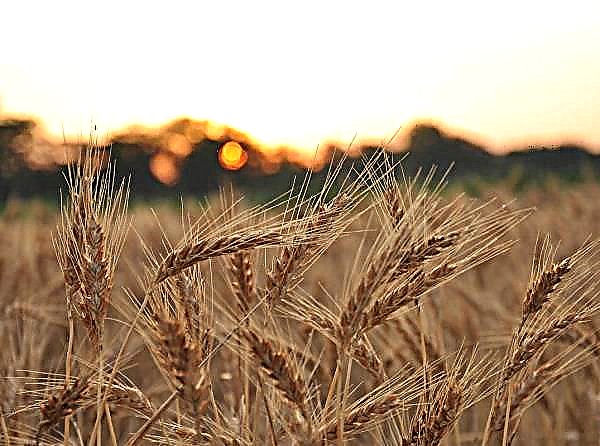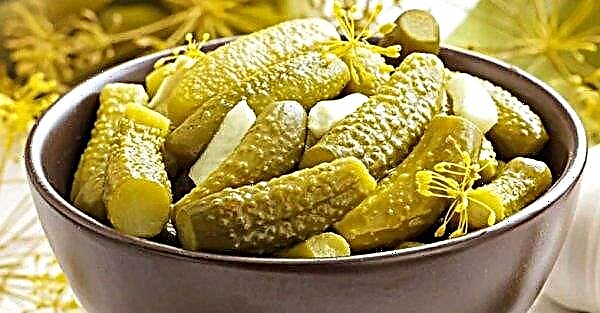In the list of the most formidable enemies of vegetable crops, the aphid occupies not the last place. The black aphid causes special damage to the plantings - this tiny creature is capable of destroying large areas of cucumber bushes in a short time. Let’s try to figure out why this insect is so dangerous, how to prevent its appearance and how to deal with aphids if it has already attacked.
Pest Description
It is worth immediately clarifying that there is no separate family with the name "black aphid". So the people call the species of aphids with black, dark blue and green-brown colors. The pest is a tiny insect, the size of which does not exceed 5 mm.
Did you know? Insects appeared on Earth much earlier than other animals - approximately 400 million years before our days. The endurance of these small creatures is so high that they are able to survive any disasters. Even if humanity exterminates itself, it is unlikely that it will completely destroy insects.
To continue the genus, the female black aphid does not require male sex cells, therefore, these parasites breed at high speed. The female lays eggs on the fodder vegetation itself, where they can safely overwinter.
The aphid's life cycle is very short - after reaching maturity, the individual lives only 2 weeks. In this short period, the female is able to lay up to 150 eggs. Larvae begin to parasitize immediately after birth. Aphids usually settle at the bottom of the leaves, where they feed on the juice of young cucumber leaves and shoots rich in carbohydrates and certain amino acids. The insect is endowed with a special proboscis, with which it can suck the juice from a fairly thick peel of plants.
Aphids usually settle at the bottom of the leaves, where they feed on the juice of young cucumber leaves and shoots rich in carbohydrates and certain amino acids. The insect is endowed with a special proboscis, with which it can suck the juice from a fairly thick peel of plants.
Determining the presence of aphids is not difficult. Small pests can be found on the leaves, flowers, ovaries and shoots of garden crops. Often aphids are affected first by weeds around the garden, then the aphid successfully moves to vegetables.
We recommend reading

Infected with spores of fungi, the plant begins to rot faster. Aphid draws all their forces from the tissues of seedlings, as a result, the garden culture dies, not having time to bear fruit.
How to deal with aphids on cucumbers
The danger of black aphids is that it damages cucumber bushes everywhere. It makes little difference where the cucumber grows - in open ground or in a greenhouse. Consider what to do if the aphid attacks could not be avoided, what effective chemical, biological and folk remedies are against it.
Using chemicals
Created a lot of chemicals that can destroy black aphids. In case of mass damage to the landings, try the following chemicals:
In case of mass damage to the landings, try the following chemicals:
- Fitoverm - A fairly effective drug, the active ingredient of which is aversectin. The substance acts on the nervous system of black individuals, thereby killing them.
- "Entobacterin" - This tool also copes well with colonies of parasites on cucumbers. After spraying the garden, the aphid becomes sick and dies after 6-7 days.
- "Metaphos" - The advantage of this drug is the long-term effect after its use. Processing bushes should be carried out in calm weather.
- Inta-Vir - The active ingredient here is cypermethrin. Its concentration is 4%. The tool causes paralysis in aphids, and then an early death. You can buy the product in the form of tablets or powder, which must be diluted with water. Spraying this product increases the overall resistance of cucumber bushes to various pests, including aphids.
- "Spark" - in addition to the active toxic substance, this product contains potassium supplements and anti-stress components that help the culture quickly overcome the "shock". The drug protects the plant from repeated attacks of the pest. Each subsequent spraying is carried out 15 days later until the aphids have completely disappeared.
- Karbofos- a toxic agent that can save cucumbers with a strong defeat of black aphids. Using a chemical gives instant results. The drug has a contact effect, exterminating mature individuals and larvae.
- "Arrow" - the active component in this case is bitoxibacillin. It is a gray powder containing spores of bacteria that cause significant damage to parasites. It is possible to completely clear the land plot in 10 days.
- "Aktara", "Tanrek" - similar means of systemic action. It will take about 7 days to wait for the result, but the effect fully meets expectations.
Aphids on cucumbers in the greenhouse appear much earlier than in the open. Greenhouse conditions are more favorable for it - the pest is warm and dry. The control measures are the same as on the open ground.
Important! Before using the listed drugs, all ripened cucumbers must be removed from the bushes. When working with chemicals, strictly observe safety precautions: protect exposed areas of the body, do not forget to wear a respirator and special glasses.
Biological methods
The fight’s biomethods are attracting natural helpers against aphids into the garden - insects and birds who like to feast on this harmful insect. Such are the flies-beetles, lacewings, ladybugs. The larvae of these insects can be used only if the aphids have already massively infected the garden and pose a threat to the seedlings.

The presented parasite can also be removed with the help of some small birds: king, tit, chicks, sparrow, robin-zaryanka, wren, linnet. The use of biological control methods automatically excludes the use of pesticides, since the latter will destroy not only aphids, but also natural helpers.
The lure of these living creatures will help the arrangement of feeders and drinking bowls, placed around the perimeter of the garden. And in order to naturally “invite” beneficial insects against aphids, plant spicy herbs with strong aromas, nettles and green manure. To lure a ladybug, plant leaf mustard near the garden.
Did you know? Pests insects devour 25-30% of the world crop every year.
With the help of folk remedies
If there is already an ovary on aphids affected by aphids, the use of chemicals becomes dangerous for the crop. Their toxic components penetrate the root system and fruits, as a result of which the entire crop will need to be disposed of. A safer solution is the use of folk remedies.
Mustard powder
An excellent option for harmless planting and human remedies are spices with pungent odors. As practice has shown, mustard is most effective in fighting aphids. From mustard powder, a solution is prepared in a proportion of 10 g of raw material per bucket of water.

To enhance the fixing properties, add to the composition of the product laundry soap, previously grated. Due to the soap, you will create inconvenience for the movement and nutrition of pests.
Soda
Not wanting to use chemistry, many summer residents are trying to cope with aphids using soda (calcined or food). The tool not only destroys harmful insects, but also saturates the bushes with calcium and protects them from diseases (powdery mildew and various rot).
To prepare a healthy solution, mix 50 g of raw materials with a bucket of water. In addition pour 3 tbsp. l sunflower oil and 5 tbsp. grated laundry soap. Soda solution can be used both during the blooming of the cucumber, and during fruiting.
Ammonia solution
To achieve a good result, a solution of ammonia (ammonia) with a concentration of 10% allows. Thanks to this tool, plantings are additionally saturated with nitrogen and grow well.
To prepare the product, dilute 50 ml of alcohol in a bucket of water. 100 g of soap or 2 tbsp will give sticky properties to the composition. washing powder. To water the plants with the resulting compound, use a wide-tip watering can. In the same form, ammonia from aphids can be used repeatedly no earlier than 15 days later. In violation of the specified period of time, a supersaturation with nitrogen is possible, which ultimately will adversely affect the state of vegetables.
In the same form, ammonia from aphids can be used repeatedly no earlier than 15 days later. In violation of the specified period of time, a supersaturation with nitrogen is possible, which ultimately will adversely affect the state of vegetables.
Vinegar
Vinegar is one of the most effective folk remedies against black aphids on cucumbers. Mix 1 tbsp. acetic acid with 1 liter of water.
Do not forget about laundry soap, it must be added in the amount of 1 tbsp. You can replace this component with another detergent, for example, for dishes (use no more than 8-10 drops).Important! Acetic solution cannot be stored. Apply it immediately after preparation. The protective effect of vinegar lasts for 7–14 days
Video: How and how to deal with aphids
Wood ash
Another effective tool that many summer residents use is wood ash. It is used both in pure form, scattering under a bush, and in the form of a solution.
Sprinkle ash on the dug up soil around each plant, then water it with boiling water. Thanks to this procedure, wood ash penetrates the sap of plants, giving it bitterness. For black aphids, the bitter taste is quite palpable. At the same time, ash does not affect the taste characteristics of cucumbers.
If you do not know how to remove aphids in June, prepare a solution from the ashes: dilute 60 g of powder in 10 liters of water. Infuse the mixture throughout the day, then boil for 30 minutes. To improve fixation, add 100 g finely ground laundry soap. Use the resulting composition to spray the infected cucumber bushes.
Tar soap
Tar soap has a good effect in the fight against aphids. A solution is prepared from it, which is used as an independent tool. Soap not only protects against parasites, but is also a preventive measure against cucumber diseases, since birch tar has healing properties. So, dissolve 100 g of grated tar soap in 10 l of water. Ready means spray the bushes.
Garlic
Black aphids cannot tolerate the smell of garlic. Just put arrows or cloves of garlic around the cucumber bushes. Or you can make a simple garlic solution. To do this, peel and chop 150 g of garlic, pour 10 l of boiling water over it and leave to infuse for a day. After the specified time, strain the composition. The product is ready to use.
Important! Apply home methods in a greenhouse and in the open air you need regularly. The fight against aphids should continue throughout the warm season. At least a few procedures will be required, since one treatment will not destroy all individuals.
Onion peel
Against black aphids also helps peel the onion. Take the raw material in an amount of 200 g, fill it with 10 liters of hot water and insist for 5 days. Additionally, add 5 drops of iodine and 2-3 crystals of potassium permanganate. As a result, the solution should acquire a light pink tint. Before processing the bushes, the resulting infusion must be filtered.
Tobacco dust
Tobacco dust helps poison aphids by sprinkling an infected bush. Raw materials can be obtained by grinding dry tobacco leaves into powder. In 2 cups of the resulting dust, add a bucket of water.
Insist for 24 hours, then strain the finished infusion and add 50 g of chopped laundry soap to it. In a similar way, a decoction of tobacco dust is prepared. Boil the mixture for 30 minutes. With a solution or a cooled infusion, you need to spray the bushes.
Celandine
It successfully copes with black aphids and infusion of celandine. You can use both the green parts of the plant and the roots. Take 3-4 kg of fresh grass (it can be replaced with 1 kg of dry raw materials).
Pour the crushed celandine with a bucket of water and leave for 1-2 days to insist. After the specified time, strain the mixture and add 2-3 tbsp. grated laundry soap.
Important! Due to the fact that celandine releases toxin, it is necessary to prepare a solution from this plant in rubber gloves. And after completing all work, wash the used inventory with water and soap dissolved in it.
Preventative measures
The appearance of black aphids on an open land plot and in a greenhouse can be prevented by following the following simple preventative measures:
- From time to time, fluff up the ground under the cucumbers. Along with loosening, weed weeds.
- Eliminate ants colonies. Use effective chemicals or alternative methods for this.
- Plan for planting cucumbers this wayso that plants in the future do not crowd in solid rows.
- Irrigate the cucumber bushes 2 times per season with a solution of laundry soap.
- With the onset of summer carefully examine the plants in the greenhouse, looking under each leaf. Ventilate the greenhouse regularly. Sometimes leave it open all night.
- In the springBefore planting seedlings, process the entire structure of the greenhouse and the ground with karbofos.


